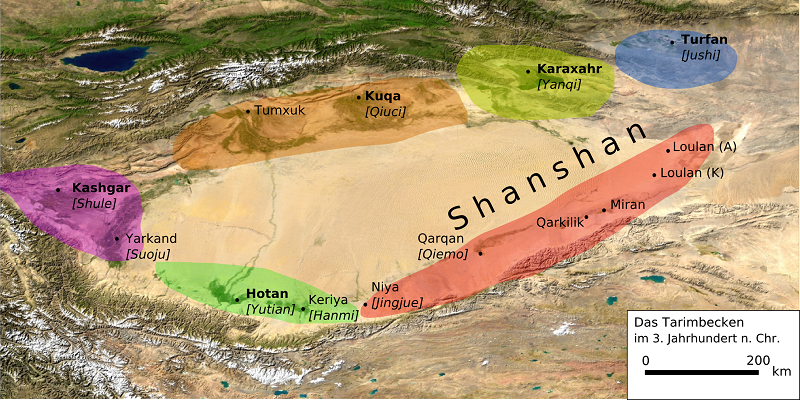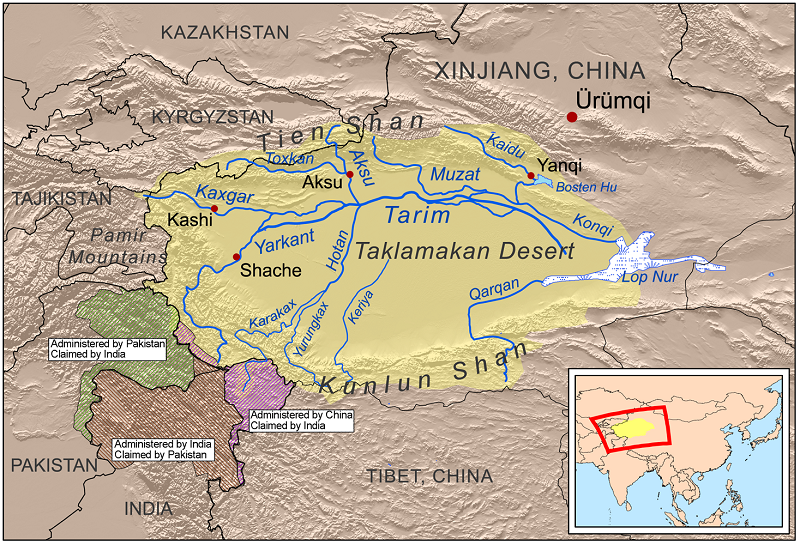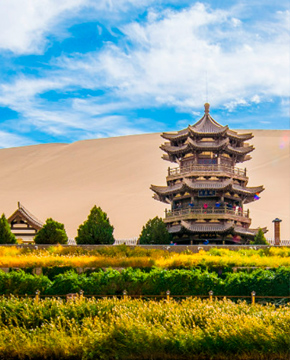As one of the most mysterious and attractive desert in Xinjiang. The hinterland of Taklimakan is rated as one of the five most beautiful deserts in China. Dunes in the hinterland of the desert are complex and varied, with duplicate sand hills and ridges like dragons on the ground, and the pyramids of Egypt are overshadowed by the height and scale of the tower dunes. When you driving along the desert highway, you will be attracted by these various honeycomb-like, feather-like, scaly dunes.
Introduction of Taklamakan Desert:
Taklamakan Desert is located in the middle of the Tarim Basin of Xinjiang Uygur Autonomous Region, it is the largest desert around China, as well as the second-largest shifting sand desert all over the world. The desert stretches 1,000 kilometres long and 400 kilometres wide, covering an area of 330,000 square metres.
The temperature of the Taklamakan Desert:
In summer, the maximum temperature could reach 67℃, temperature difference between day and night being over 40℃. While the average annual precipitation is no more than 100 mm, with the lowest rainfall 4 to 5 mm, the annual evaporation is as high as 2,500 mm to 3,400 mm.
Formation of Taklamakan Desert

According to research, Taklamakan Desert is likely to be formed more than four million years ago. After an in-depth analysis of deposits at the edges of southern Tarim, scientists have found loess affected by wind action is at least four million years old.
Features of Taklamakan Desert

The area of Taklamakan Desert:
The Taklamakan Desert has an area of 337,000 km2 (130,000 sq mi), making it slightly smaller than Germany, and includes the Tarim Basin, which is 1,000 kilometres (620 mi) long and 400 kilometres (250 mi) wide. It is crossed at its northern and its southern edge by two branches of the Silk Road as travelers sought to avoid the arid wasteland. It is the world's second-largest shifting sand desert with about 85% made up of shifting dunes ranking 16th in size in a ranking of the world's largest deserts.
The desert highways and railway:
The People's Republic of China has constructed two cross-desert highways. The Tarim Desert Highway links the cities of Hotan (on the southern edge) and Luntai (on the northern edge), and the Bayingol to Ruoqiang road crosses the desert to the east. In recent years, the desert has expanded in some areas, its sands enveloping farms and villages as a result of desertification.
The Golmud-Korla Railway (presently, under construction; expected completion time, 2019) will cross the Taklamakan as well.
Animals and Plants of Taklamakan Desert
On the open land of Taklamakan Desert, flocks of antelope, bears, lynxes, woodpeckers, swans, mustang, Yarkand hares, foxes, wolves, are also visible.
Taklamakan Desert, surrounded by grandiose mountains, has Mount Tianshan in the north, Kunlun Mountain in the south, Pamirs in the west. Under such circumstances, the vegetation of Taklamakan Desert is extremely scarce, with sparse Chinese tamarisk, reed and others. However, the edges of the desert – the area where dune and river valley and delta joint and the area where groundwater is near the earth's surface – sees relatively rich plants.
For animals, they are not much either, except on the edges of the desert and river valley and delta where there are aquatic weeds. On the open land, flocks of antelope, bears, lynxes, woodpeckers, swans, mustang, Yarkand hares, foxes, wolves, are also visible.
Scenery of Taklamakan Desert
Overlooking from Hongbai Shan, which has a height of 1,413 meters above sea level, you will be shocked by another kind of vastness of the desert. At sight of it, people will feel how small the human is when compared with the earth. Shutterbugs can never miss such a spectacle!
Diversiform-leaved poplars in Xinjiang top those elsewhere in China in terms of beauty and fortitude. In deserts close to Tarim in Luntai, you can discover large-scaled and imposing diversified-leaved poplars; the unique diversiform-leaved poplar park around China can also be explored. 100 kilometres away from the south Luntai, primitive diversiform-leaved poplars are available, some with the trunk being more than one metre diameter. When it comes to autumn, they become a vast golden sea. In the south of Taklamakan Desert, you can often find amazing diversiform-leaved poplars; they stand as if they were fortitudinous soldiers, guarding the vast expanse of desert.
Culture of Taklamakan Desert
Taklamakan Desert used to have a glorious history and culture, with ancient Silk Road crossing the south end of Taklamakan Desert.
 Most popular desert trekking tour package
Most popular desert trekking tour package
11 Days West China Adventure to Taklamakan desert
Features: Follow the footstep of Mark Polo, knowing the history of Western Region, visiting the ruins along the Silk Road, driving across the Taklamgan desert.we are the best choice for you to experience the folklore of Xinjiang.



